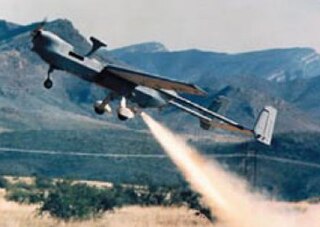Related Research Articles

The Defense Advanced Research Projects Agency (DARPA) is a research and development agency of the United States Department of Defense responsible for the development of emerging technologies for use by the military.
The United States Armed Forces are the military forces of the United States. The armed forces consist of six service branches: the Army, Marine Corps, Navy, Air Force, Space Force, and Coast Guard. All six armed services are among the eight uniformed services of the United States, along with the U.S. Public Health Service Commissioned Corps and the NOAA Commissioned Officer Corps.

The Northrop Grumman RQ-4 Global Hawk is a high-altitude, remotely-piloted surveillance aircraft introduced in 2001. It was initially designed by Ryan Aeronautical, and known as Tier II+ during development. The RQ-4 provides a broad overview and systematic surveillance using high-resolution synthetic aperture radar (SAR) and electro-optical/infrared (EO/IR) sensors with long loiter times over target areas.

The IAI RQ-5 Hunter unmanned aerial vehicle (UAV) was originally intended to serve as the United States Army's Short Range UAV system for division and corps commanders. It took off and landed on runways. It used a gimbaled EO/IR sensor to relay its video in real time via a second airborne Hunter over a C-band line-of-sight data link. The RQ-5 is based on the Hunter UAV that was developed by Israel Aerospace Industries.

The Alliant RQ-6 Outrider unmanned aerial vehicle (UAV) was designed to provide near-real-time reconnaissance, surveillance, and target acquisition information to United States Marine Corps air/ground task forces, United States Army brigades, and deployed United States Navy units that was small enough for an entire system to be contained on two Humvees and trailer and transported on a single C-130 Hercules cargo aircraft.

Surveillance aircraft are aircraft used for surveillance. They are primarily operated by military forces and government agencies in roles including intelligence gathering, maritime patrol, battlefield and airspace surveillance, observation, and law enforcement.

A military aircraft is any fixed-wing or rotary-wing aircraft that is operated by a legal or insurrectionary military of any type. Military aircraft can be either combat or non-combat:

An unmanned aerial vehicle (UAV), commonly known as a drone, is an aircraft without any human pilot, crew, or passengers onboard. UAVs were originally developed through the twentieth century for military missions too "dull, dirty or dangerous" for humans, and by the twenty-first, they had become essential assets to most militaries. As control technologies improved and costs fell, their use expanded to many non-military applications. These include aerial photography, area coverage, precision agriculture, forest fire monitoring, river monitoring, environmental monitoring, policing and surveillance, infrastructure inspections, smuggling, product deliveries, entertainment, and drone racing.

Black project is an informal term used to describe a highly classified, top-secret military or defense project that is not publicly acknowledged by government, military personnel, or contractors.

The Northrop Grumman MQ-4C Triton is an American high-altitude long endurance unmanned aerial vehicle (UAV) developed for and flown by the United States Navy and Royal Australian Air Force as a surveillance aircraft. Together with its associated ground control station, it is an unmanned aircraft system (UAS). Developed under the Broad Area Maritime Surveillance (BAMS) program, the Triton is intended to provide real-time intelligence, surveillance and reconnaissance missions (ISR) over vast ocean and coastal regions, continuous maritime surveillance, conduct search and rescue missions, and to complement the Boeing P-8 Poseidon maritime patrol aircraft.

Military aviation comprises military aircraft and other flying machines for the purposes of conducting or enabling aerial warfare, including national airlift capacity to provide logistical supply to forces stationed in a war theater or along a front. Airpower includes the national means of conducting such warfare, including the intersection of transport and warcraft. Military aircraft include bombers, fighters, transports, trainer aircraft, and reconnaissance aircraft.

Future Combat Systems (FCS) was the United States Army's principal modernization program from 2003 to early 2009. Formally launched in 2003, FCS was envisioned to create new brigades equipped with new manned and unmanned vehicles linked by an unprecedented fast and flexible battlefield network. The U.S. Army claimed it was their "most ambitious and far-reaching modernization" program since World War II. Between 1995 and 2009, $32 billion was expended on programs such as this, "with little to show for it".

The Marine Corps Intelligence is the intelligence arm of the United States Marine Corps (USMC) and an element of the United States Intelligence Community. The Director of Intelligence supervises the Intelligence Department of HQMC and is responsible for policy, plans, programming, budgets, and staff supervision of Intelligence and supporting activities within the U.S. Marine Corps as well as supervising the Marine Corps Intelligence Activity (MCIA). The department supports the Commandant of the Marine Corps (CMC) in his role as a member of the Joint Chiefs of Staff (JCS), represents the service in Joint and Intelligence Community matters, and exercises supervision over the MCIA.

Aeronautics Ltd. is an Israeli company specializing in the manufacturing of Unmanned Aerial Systems for military uses. Since its establishment in 1997, the company has sold its products to more than 20 defense, military and homeland security customers in 15 countries. Its headquarters are in Yavne, Israel.

The Agency for Defense Development is the South Korean government agency for research and development in defense technology, funded by the Defense Acquisition Program Administration (DAPA). It was established in August 1970 under the banner of the self-reliant national defense promoted by President Park Chung Hee.

The Operational Test and Evaluation Force (OPTEVFOR) is an independent and objective agency within the United States Navy for the operational testing and evaluation (OT&E) of naval aviation, surface warfare, submarine warfare, C4I, cryptologic, and space systems in support Navy and Department of Defense acquisition programs.
The GIDS Uqab is a tactical unmanned reconnaissance aerial vehicle built and developed by the Global Industrial Defence Solutions (GIDS) for the joint drone program of the Pakistan Navy and Pakistan Army. The Uqab is a tactical system which can be used for damage assessment, reconnaissance operations, artillery fire corrections, and can perform other variety of security and military operations.

The Defense Acquisition Program Administration was founded on 1 January 2006 as part of a comprehensive reform of the defense acquisition project, including the introduction and development of military equipments, and is a central administrative agency of the South Korean Ministry of National Defense. The DAPA has exclusive authority to plan and budget defense development and procurement programs for the Republic of Korea Armed Forces and to enact Korean Defense Specifications (KDS). Sub-agencies of DAPA include the Agency for Defense Development (ADD) responsible for defense development and Defense Agency for Technology and Quality (DTaQ) responsible for defense improvement programs and defense quality certification tests.

An airborne sensor operator is the functional profession of gathering information from an airborne platform and/or oversee mission management systems for academic, commercial, public safety or military remote sensing purposes. The airborne sensor operator is considered a principal flight crew or aircrew member.
The Buckeye system is an operational airborne surveying system that provides high-resolution spatial imagery over an area of interest to support military operations involved with intelligence, surveillance, and reconnaissance. Once mounted on a helicopter or an unmanned aerial vehicle (UAV), it incorporates visual information from a digital camera and elevation data from a Light Detection and Ranging (LIDAR) system to create a two and three-dimensional colored map with orthorectified, 4 to 6-inch resolution.
References
- ↑ B.W. Carmichael (Colonel), T.E. DeVine (Major), R.J. Kaufman, (Major), P.E. Pence (Major), R.E. Wilcox (Major). Research Paper (PDF). published by The U.S. Air-force August 1996. Archived from the original (PDF) on May 16, 2006. Retrieved 2015-12-10.
{{cite book}}: CS1 maint: multiple names: authors list (link) - ↑ Federation of American Scientists. article . Retrieved 2015-12-10.
- ↑ Professor E.P. Richards J.D., M.P.H. - Summary & facsmile published by Louisiana State University [Retrieved 2015-12-10]
- ↑ W.E. Odom - text published by Yale University Press, October 1, 2008, 272 pages, ISBN 030013035X Political Science [Retrieved 2015-12-10]
- ↑ DARO - Unmanned Aerial Vehicles (UAV) Program Plan [Retrieved 2015-12-10]
- ↑ profile published and written by the Office of the Director of National Intelligence [Retrieved 2015-12-10]